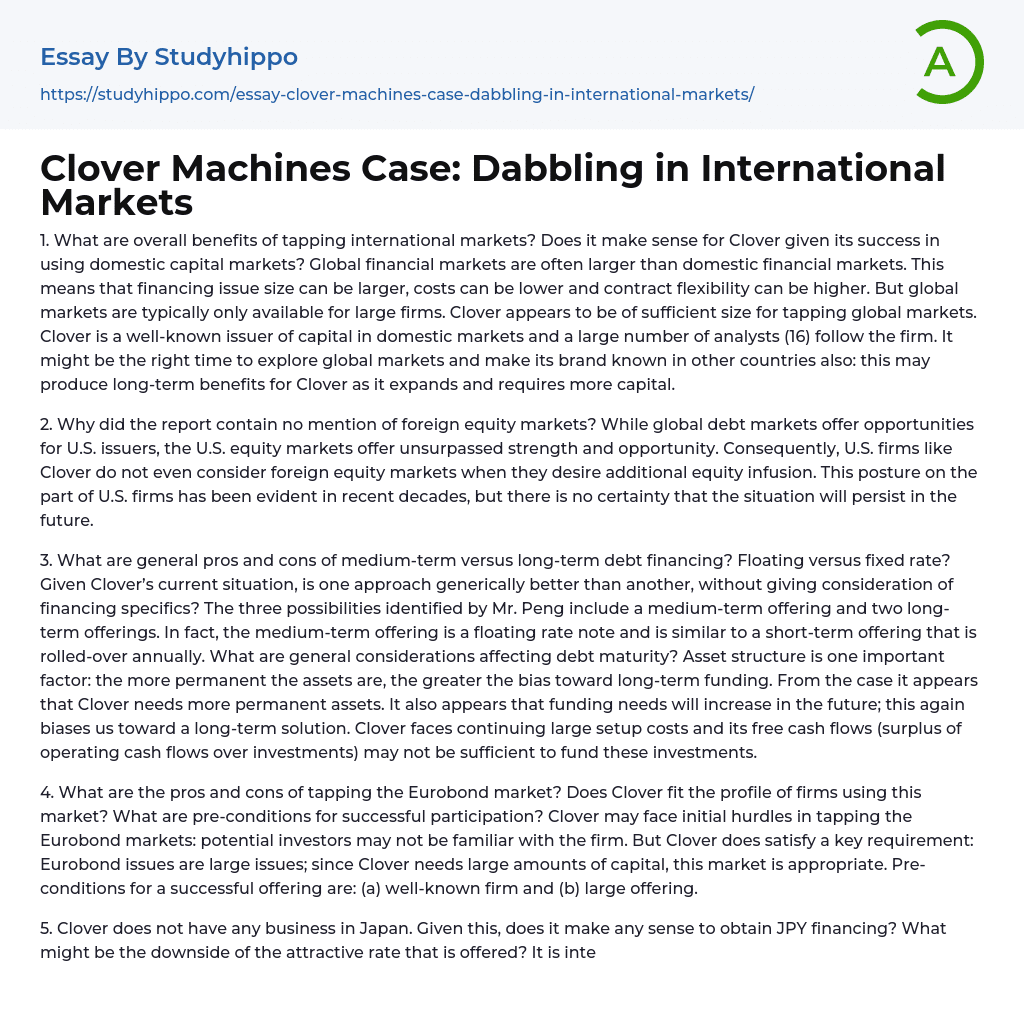

Clover Machines Case: Dabbling in International Markets Essay Example
1. What are overall benefits of tapping international markets? Does it make sense for Clover given its success in using domestic capital markets? Global financial markets are often larger than domestic financial markets. This means that financing issue size can be larger, costs can be lower and contract flexibility can be higher. But global markets are typically only available for large firms. Clover appears to be of sufficient size for tapping global markets. Clover is a well-known issuer of capital in domestic markets and a large number of analysts (16) follow the firm. It might be the right time to explore global markets and make its brand known in other countries also: this may produce long-term benefits for Clover as it expands and requires more capital.
2. Why did the report contain no mention of foreign equity markets? While glo
...bal debt markets offer opportunities for U.S. issuers, the U.S. equity markets offer unsurpassed strength and opportunity. Consequently, U.S. firms like Clover do not even consider foreign equity markets when they desire additional equity infusion. This posture on the part of U.S. firms has been evident in recent decades, but there is no certainty that the situation will persist in the future.
3. What are general pros and cons of medium-term versus long-term debt financing? Floating versus fixed rate? Given Clover’s current situation, is one approach generically better than another, without giving consideration of financing specifics? The three possibilities identified by Mr. Peng include a medium-term offering and two long-term offerings. In fact, the medium-term offering is a floating rate note and is similar to a short-term offering that is rolled-over annually
What are general considerations affecting debt maturity? Asset structure is one important factor: the more permanent the assets are, the greater the bias toward long-term funding. From the case it appears that Clover needs more permanent assets. It also appears that funding needs will increase in the future; this again biases us toward a long-term solution. Clover faces continuing large setup costs and its free cash flows (surplus of operating cash flows over investments) may not be sufficient to fund these investments.
4. What are the pros and cons of tapping the Eurobond market? Does Clover fit the profile of firms using this market? What are pre-conditions for successful participation? Clover may face initial hurdles in tapping the Eurobond markets: potential investors may not be familiar with the firm. But Clover does satisfy a key requirement: Eurobond issues are large issues; since Clover needs large amounts of capital, this market is appropriate. Pre-conditions for a successful offering are: (a) well-known firm and (b) large offering.
5. Clover does not have any business in Japan. Given this, does it make any sense to obtain JPY financing? What might be the downside of the attractive rate that is offered? It is interesting that one of the alternatives is a Samurai issue (JPY issue in Japan). Such an issue might be quite valuable if Clover has business in Japan and can offset JPY operating cash flows against JPY debt related cash flows. But even without this benefit, there are advantages to “diversifying” funding sources (a topic discussed in chapters 10 and 11). One problem that Clover needs to consider is the potential for JPY to strengthen;
if this happens, debt service (that is, repayment of interest and principal) will be at disadvantageous currency rates.
6. The report shows no indication or model of how to translate the effects of obtaining floating rate financing. Mr. Bent resolved to ask Mr. Peng to construct a spreadsheet—using plausible scenarios—to demonstrate cash flow consequences of the floating rate note. There are two complications in modeling cash flows related to the FRN. First, market interest rates can change. The coupon is set at EURIBOR + 30bp. The current level of EURIBOR is 4.3%, so this implies that the first coupon payment is 4.6%. Clover expects the rate to diminish somewhat, so one could model a rate such as EURIBOR = 4%. Second, interest payments are denominated in EUR. Clover is a US firm and would be interested in cash flows converted to USD. Spot EURUSD = 1.60 with a plausible range of 1.50 – 1.70.
- Accounting essays
- Marketing essays
- Automation essays
- Business Cycle essays
- Business Model essays
- Business Operations essays
- Business Software essays
- Corporate Social Responsibility essays
- Infrastructure essays
- Logistics essays
- Manufacturing essays
- Multinational Corporation essays
- Richard Branson essays
- Small Business essays
- Cooperative essays
- Family Business essays
- Human Resource Management essays
- Sales essays
- Market essays
- Online Shopping essays
- Selling essays
- Strategy essays
- Management essays
- Franchising essays
- Quality Assurance essays
- Business Intelligence essays
- Corporation essays
- Stock essays
- Shopping Mall essays
- Harvard Business School essays
- Harvard university essays
- Trade Union essays
- Cooperation essays
- News Media essays
- Waste essays
- Andrew Carnegie essays
- Inventory essays
- Customer Relationship Management essays
- Structure essays
- Starting a Business essays
- Accounts Receivable essays
- Auditor's Report essays
- Balance Sheet essays
- Costs essays
- Financial Audit essays
- International Financial Reporting Standards essays
- Tax essays
- Accountability essays
- Cash essays
- Principal essays



